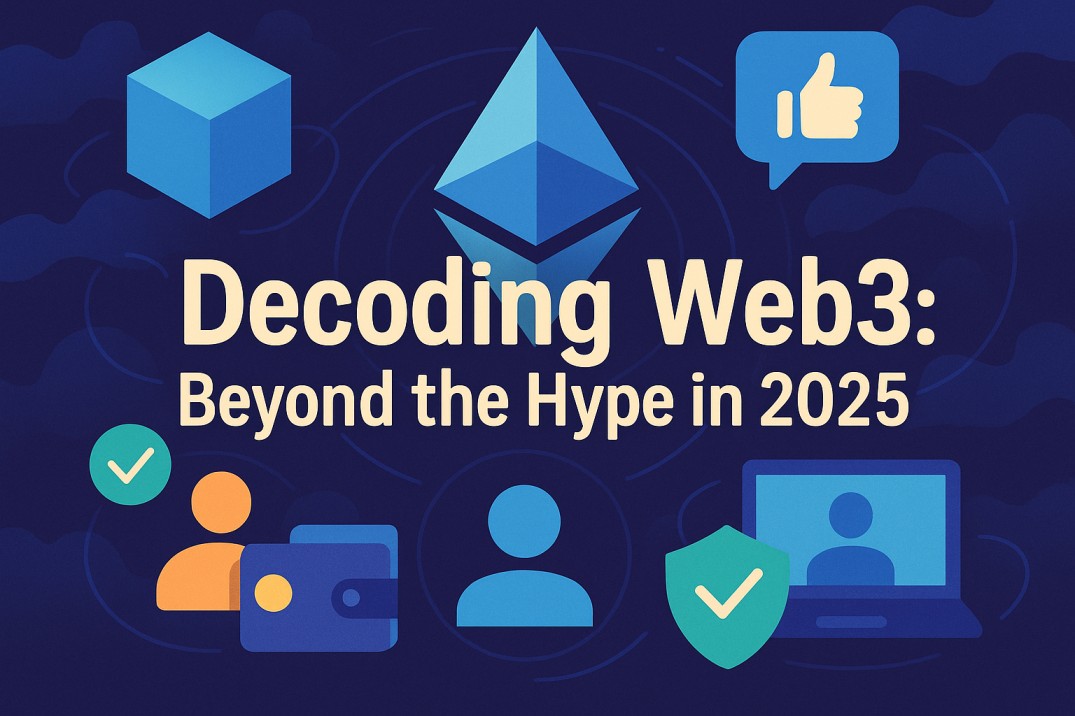Web3 (short for Web 3.0) represents the latest stage of the internet: a web where users own their data, own their identity, and are able to connect with other users directly — not mediated by big-tech.
Web1 (1990s–early 2000s): Read-only internet
You could browse static websites, but you couldn’t do much else.
Web2 (2005–now): Read & write
Social media, apps, e-commerce. But big platforms (like Google, Facebook) control your data and make money from it.
Web3 (Emerging now): Read, write & own
You own your content, identity, and assets. Everything is peer-to-peer and powered by crypto and smart contracts.
It is built on blockchain, therefore all interactions are decentralized, transparent, and secure.
In the years past, the term “Web3” had been ubiquitous. You weren’t able to scroll Twitter or enter a tech podcast without hearing about a decentralized future. Back then all there was to consider was NFTs, DeFi, DAO and dizzying coin launches. Some saw the hooks of the internet; others merely viewed it as the technology community’s next buzzword.
Now, in 2025, the hype has settled down—but that may be the best thing that could have happened.
Because underneath the noise, Web3 is gaining defining features. Instead of a speculative playground of pixelated apes and overnight millionaires, it is turning into something far more intriguing: a new operating layer of the internet which is starting to work.
If you haven’t popped in to see what Web3 looks like lately, you might be surprised. Decentralized social platforms aren’t just “neat projects.” The punters on social have figured out how to publish, get fans or audiences, and take revenue (not a 30% cut) from their fans directly. Some platforms allow you to “own” your social graph, which lets you carry your followers, reputation, and identity with you, app-to-app! It’s mostly subtle, but revolutionary.
When it comes to finance, after the 2022-2023 saw the biggest crash of them all, people assumed DeFi was done for. But the best builders in the world continued to build, and now in 2025, we are seeing DeFi 2.0 – it’s secure, regulated, and tied to real world assets. It’s not yield farming – it’s utility! Even Bank of America has looked into putting blockchain into an application for quicker settlements and transparency.
Surely, Web3 identity is another under-the-radar win. In a world where “Sign in with Google” and “Sign in with Apple” are the norm, the notion of having your login—your own portable, private identity—is a remarkable concept. Wallets are starting to function as digital passports, representative of not just your coins, but your credentials, memberships, even diplomas. And then we have things like zero-knowledge proofs and soulbound tokens, which provide soundness of data ownership without actually exposing the data. That’s the type of privacy-forward future that we have all been waiting for.
Even gaming is improving. The days of “play-to-earn” and the dubious implications of participating in cash grabs are behind us. The best Web3 games today are about enjoyment; ownership is just integrated. Now, you’re able to buy a skin, trade a skin, rent a skin, take that skin into another world. We have flipped the focus from speculation to player empowerment.
And this brings us to the biggest change: web3 is no longer screaming. Web3 is building.
That is not to say that it is perfect. Onboarding continues to be a challenge. Wallets, gas fees, chains, bridges—it’s a lot to take in for a newcomer. Regulators are still figuring things out in many corners of the world. For every good project, there are still a couple of scams lurking on the fringes. But these are not indications of failure—they’re signs of a young tech ecosystem maturing. So no, Web3 hasn’t died. To the contrary, it just quit trying to dazzle you. In doing so, it’s more likely than ever to be what it was always intended to be: a better internet, owned by all of us, not just a few.
Augmented Reality for Business and Beyond: A Practical Guide
Explore more tech updates here → Click here


1 thought on “The Rise of Web3 in 2025: What You Need to Know”